Blind area with paving slabs around the house
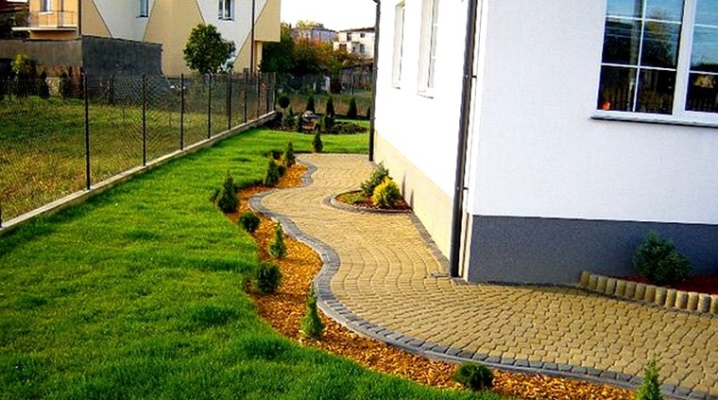
The final stage of the construction of buildings and structures involves the mandatory installation of a blind area. Its function is to protect the foundation of the house from the adverse external effects of moisture and prevent water from flowing into the ground. A properly designed covering prevents the ground from swelling even during the most severe winter cold. Most often, the blind area is made from paving slabs.
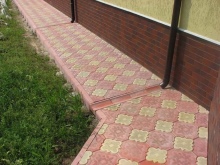


Advantages and disadvantages
The blind area is a moisture-proof coating that runs along the entire perimeter of the building with a slight slope in the direction from the building. It is installed to protect the foundation of the building from melt and storm water.
For many years, concrete was used for arranging the blind area, however, despite its availability and low price, in recent years it has given way to flexible, but dense paving stones. Such popularity of the latter is explained by its undoubted advantages and exceptional performance characteristics.
- Long service period. Even after several years of use, paving slabs look beautiful and retain their decorative appearance. According to experts, it will protect the building for at least 30-40 years. The coating is not afraid of the negative effect of precipitation, temperature fluctuations and other unfavorable factors.
- The ability to install paving stones with your own hands. In order to make a path from paving slabs, it is not at all necessary for a home craftsman to turn to the services of hired specialists-stackers, as well as to use expensive equipment. All the necessary work can be done very quickly and easily, without preliminary design of the reinforcing frame.
- Decorative look. The tile has a beautiful surface, it is presented in a large selection of colors, textures and design solutions. Paving stones always look more aesthetically pleasing than concrete and asphalt concrete pavements, they are harmoniously combined with garden paths and other elements of landscape design. The garden and other green areas adjacent to the blind area look more well-groomed and neat.
- Resistant to UV rays. Under the influence of ultraviolet light, the material retains its dense and solid structure. Even on the hottest days, it does not crack or change color.
- Environmental friendliness. Paving slabs are safe. It does not emit harmful volatile fumes, since only natural materials are used for its manufacture.
- Maintainability. If it is necessary to repair the tiles, individual fragments of the structure can be removed without dismantling the entire blind area. After completing all the work, the tiles are also easy to put back.
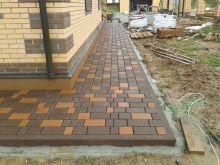
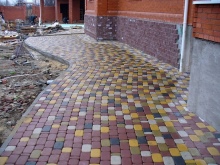
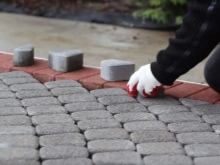
However, paving slabs also have disadvantages. So, after melting snows and prolonged rains, moisture seeps into the ground through the gaps between the plates. There it stagnates and, as a result, a gradual destruction of the structure begins. The hygroscopicity of paving stones leads to the fact that with a sharp decrease in temperature, ice appears on the surface.
In addition, the constant repetition of the freezing and defrosting cycles causes premature destruction of the structure of the material from the inside. Thus, the tile does not provide an opportunity to 100% protect the foundation from the adverse effects of moisture.
Therefore, when installing the coating, it is imperative to carry out waterproofing and insulation, and this significantly increases the time, effort and money spent on work.

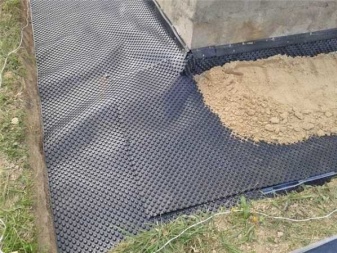
In addition to moisture, paving slabs also absorb other liquids. For example, if blind areas are adjacent to a parking lot, then the tile will absorb exhaust gases and gasoline. On hot days, when heated, carcinogenic vapors will begin to evaporate and can harm people living in the house. If a dog lives on a tiled base in a booth, then in summer the air in this area will be filled with an unpleasant smell of pet feces.
If the installation is not performed correctly, grass begins to sprout between the individual tiles, and this also destroys their structure.
When buying paving stones, there is always a high risk of "running into" low-quality soft products made by handicraft. Little-known components and violation of technology, as well as imperfection of equipment for performing pressing, has a most deplorable effect on the performance and quality of the finished tile. Such paving stones begin to break almost immediately after laying, and often they absorb too much water and cannot withstand the weight of a person. It is very easy to distinguish a fake from a tile made in compliance with all established standards. To do this, you just need to knock the tiles on the tiles - if you have a quality product in front of you, then you will definitely hear a light ringing.
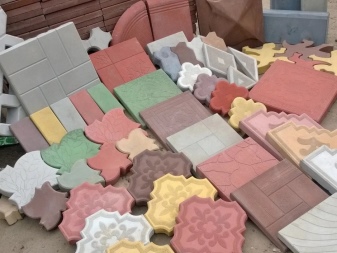
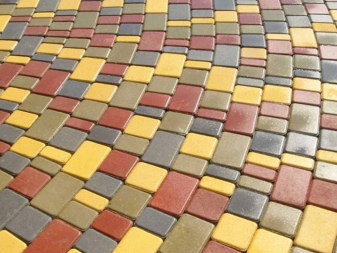
How to prepare the place?
Installation of paving slabs on the blind area must begin with the preliminary preparation of the site - "bed". If there is an old concrete or asphalt pavement, then it must be dismantled. In addition, it is necessary to remove part of the foundation located under the pillow. If the structure is new, then the soil layer will have to be removed. If possible, you should additionally consider the storm sewer system.
In order to completely minimize the risk of voids in the ground, and to allow the substrate to compact, experts advise to wait 12-14 months after the foundation itself is built.
However, do not delay too much - if the pause is longer, precipitation and melt water can damage the base.
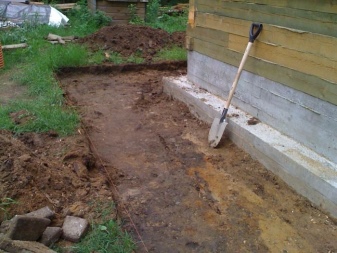
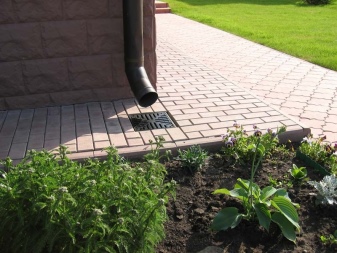
The width of the bed is directly influenced by the design of the curb. It is best to match it to the size of the tile, otherwise you will have to trim the tile material when laying it. The depth of the blind area is calculated taking into account the height of individual soil layers, usually it is approximately 200 mm, but when arranging the bed, a parameter of 400 mm should be taken.
If the soil layer consists mainly of clay, then there is no need to equip an earthen castle. When the soil layer is removed, large heaps of earth inevitably appear. You need to decide in advance where you will move them, otherwise such an embankment can create problems when moving around the site.
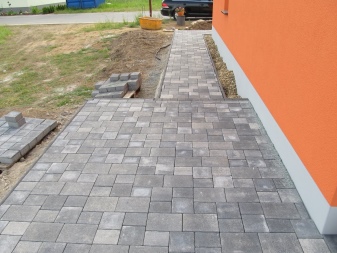
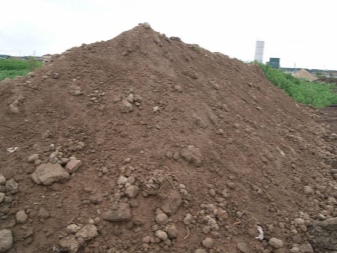
Markup
When decorating a paving area, it is extremely important to carry out accurate markings. To do this, metal or wooden pegs are fixed in the corners of the bed and a rope is pulled between them. The tension should be as even and strong as possible; when carrying out work, it is better to take the building level. In accordance with the established norms SNiP III-10-75, edge bending of more than 10 mm is not allowed. This requirement is mandatory when laying paving stones in straight sections. Otherwise, the quality of the markup directly depends on the selected parameters of your future blind area. All other measuring actions are performed after the preparation of the trench.

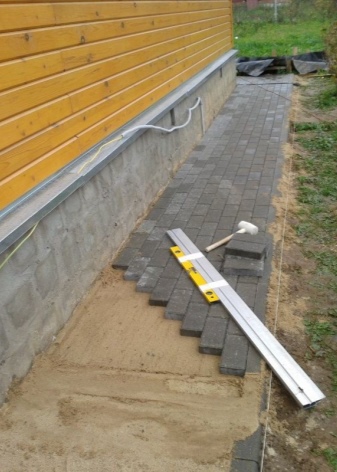
How to create a foundation correctly?
In order for the paving area to serve for several decades, you should arrange a reliable foundation for your future structure. In section, the base resembles a puff pastry. It must be laid in several successive layers in strict compliance with all technological requirements.
Due to the ability of paving slabs to absorb moisture, it is very important to provide high-quality water protection - this will prevent the flow of rain and melt water to the foundation.Construction polyethylene or roofing material is best suited for this task. The latter option is considered more reliable and practical, but the first one is cheaper and easier to install.
That is why most of the craftsmen who design the blind area with their own hands most often resort to polyethylene.
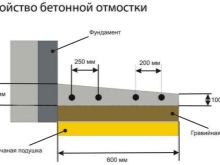
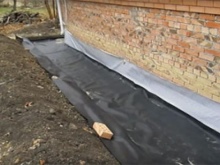

Laying the waterproofing layer takes very little time. To do this, the canvas is rolled out, if necessary, cut with scissors or a clerical knife into fragments of the required size, then put on top of a layer of clay or gravel. The edge of the waterproofing material that is adjacent to the wall of the house should be bent and fixed on a vertical surface with a metal strip.
On top of the polyethylene, river or construction sand is poured into a layer of 4-6 cm. It must be properly leveled (for this you can use a solid sheet of plywood), and then tamped. To facilitate the work, the sand can be slightly moistened - this way it will better hold its shape and less crumble.
At this stage, you can install a curb, if one is planned. To do this, pull the rope along the inner edge of the future curb at the exposed level and dig a trench. Its width should be equal to the thickness of the curb plus 20-25 cm, since there must be at least 10 cm of concrete on both sides of the curb.
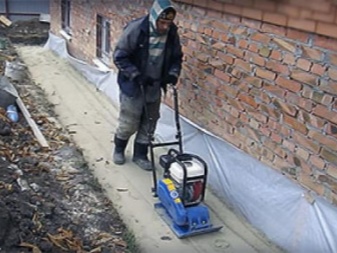
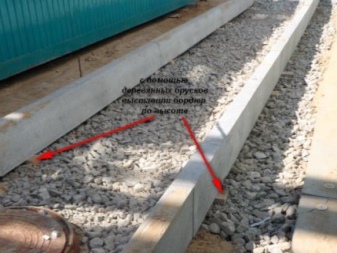
After that, they expose the formwork from boards about 10 cm wide, knead a thick concrete solution of cement and sand in a ratio of 1 to 3, which is thrown into the formwork. The curb is placed along a thread, immersing it in the mortar by 5-7 cm. In order for the fixation to gain the necessary strength, it is necessary to give the solution the opportunity to grab, depending on the weather, it takes 1-2 days.
A layer of crushed stone or fine gravel with a thickness of 9-10 cm is poured onto the sand on top and also well tamped. From above, the crushed stone is again covered with sand and compacted.
At this point, all the preparatory work can be considered completely finished. Next, they move on to making a blind area of paving stones around the house.

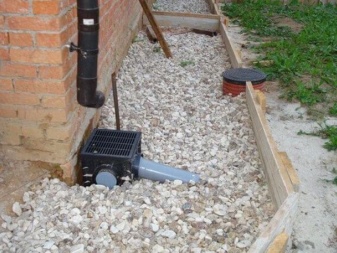
How to make a blind area with your own hands?
Let us dwell in more detail on the step-by-step instructions for arranging a paving area. It is not at all difficult to carry out these works.
Styling
Laying schemes for paving stones can be different, but in any case, it is better to start laying from a corner.... Try to fit the tiles as tightly as possible. If their edges are not even enough, then use small wood chips. They should be inserted between individual tiles so that the distance at the junction points does not exceed 2-3 mm - this will allow even those tiles with the most curved edges to be laid out as evenly as possible.
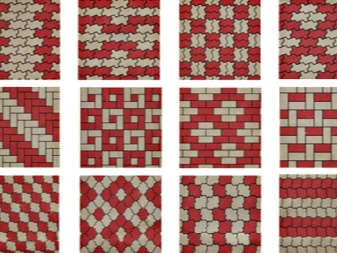
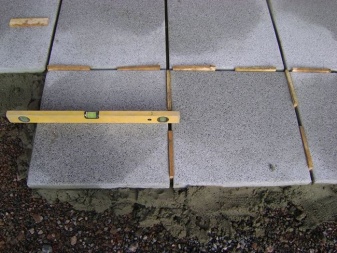
When the paving stones are laid out, concrete should be prepared, it is used as a fixer to secure the blind area. It is best to make a solution of 1 part dry cement and 3 parts sand (there should be a little water). The consistency should be thick, otherwise the cement milk will completely go into the pillow. This will significantly reduce the density of the concrete and the quality of the paving. It is necessary to mix a small volume of concrete solution at one pass - at the rate of its consumption per hour. With longer storage, especially in hot weather, it begins to thicken and this greatly increases the complexity of laying.
Remove the first row of tiled tiles and apply concrete grout on top of the sand layer. You shouldn't feel sorry for him - the layer should be thick enough, about 4 cm.
Try to put more concrete around the house. This will create a slight slope that will allow water droplets to quickly roll off the protective strip.

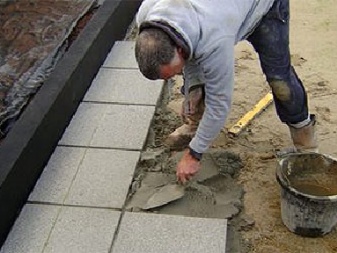
Fixing the paving stones in their original place, you should carefully tap it with a rubber or wooden hammer, it should sink a little in the concrete - this ensures the most durable fixation.
Important. Do not use a regular metal hammer, as any blow, even the weakest one, will split the paving stones. If you have only this tool at your disposal, then lay a board on top of the covering and knock on it. In this way, you can reduce the risk of chips, cracks and other damage.
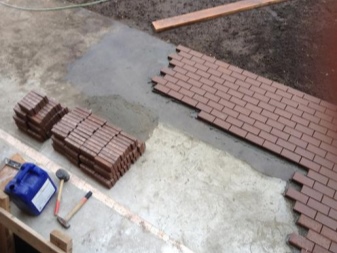
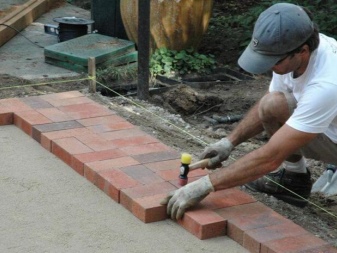
Lay the tiles neatly one row after another, remove no more than one row at a time. If necessary, use a construction level - the strip must be precisely aligned along and with a slight slope across.
After finishing work, you need to wait for the concrete to dry. As a rule, this requires at least two days, and in cold and rainy weather, it is better to increase the time to 3-4 days. At this time, you should not walk around the site and put heavy objects on the blind area. Otherwise, the paving stones will shift - such a blind area will turn out to be uneven.
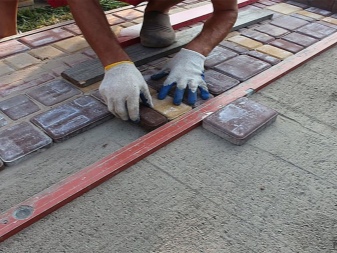
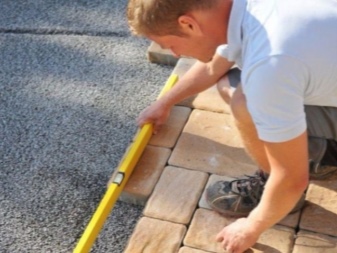
Grouting
When the blind area is completely made, and the concrete layer has hardened and firmly holds the tile, you can proceed to the final stage of work, the design of the joints. If wood chips have been used during installation, they must be removed. A variety of materials can be used to fill the resulting seams. The simplest and most budgetary option is considered to be ordinary sand.... It is able to quickly solve the problem of rainwater and melting snow - moisture will quickly seep through the sand, and the sidewalk will remain dry. Moisture, having reached the waterproofing material, simply slide down due to the slope made in the direction from the building.
The only drawback of this solution is its fragility. Under the influence of natural factors, as well as during the cleaning of the territory, the sand is weathered or washed out, therefore after 3-5 years you will have to renew it by pouring it into the empty cracks. Such work does not take much time, money and effort, since it is quite easy to fill the seams with sand. To do this, on the one hand, sand is poured, and with the help of thick cardboard, a piece of fiberboard or plywood, it is distributed to the other.
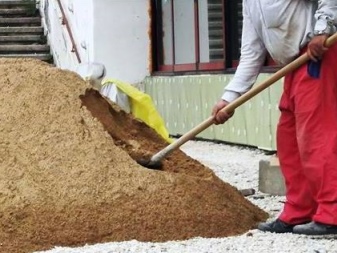
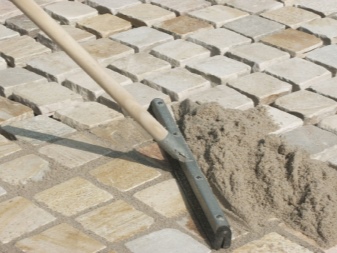
Concrete is considered a more reliable and durable option.... The composition is prepared in the same proportion as for the installation of the base of the blind area, that is, they mix cement with sand in a ratio of 1 to 3. In this case, the surface of the blind area will be perfectly smooth.
In addition, cement does not have the ability to wash out and weather. However, with this approach, it is very important to observe the slope of the blind area so that the drops of water immediately roll down without stagnating on the slabs. The seams are filled with concrete with the simplest brush. In this case, it is necessary to ensure that the filler does not just cover the gaps from above, but also completely fills them, otherwise it will crack very quickly from a simple walk of users.
At the end of grouting, it is necessary to wait a couple of days for the concrete solution to gain the required strength. After that, you can safely use the ready-made paving area as a comfortable path for walking.
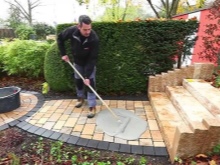
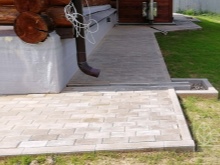

Registration
When arranging a blind area, many make common mistakes.
- Wrong width. Visually, the blind area looks like a wide strip running from all sides of the building. It is important to understand that if done correctly, it will accurately and tightly dock with the base of the structure. In accordance with the standards, the width of the blind area should not be less than 80 cm. The maximum allowable parameter has not been set, in this case the rule works - "the more, the better." However, it should be understood that even with a properly organized roof drainage system, raindrops will fall on the ground. It is important that they do not fall on open land. Therefore, when planning the blind area, it is necessary to lay its width so that it is 20-25 cm wider than the parameters of the roof overhang.
- Stagnant water... If the water that has rolled down from the roof remains on the surface of the blind area, forming puddles near it, this indicates that the creators did not foresee the slope of the paving stone. In accordance with the established requirements, the transverse slope of the protective strip must be at least 10%.For example, if the width of the section is 1 meter, then the difference in height between its longitudinal sides should be at least 10 cm.
- It makes sense to arrange drain trays around the entire outer perimeter of the blind area. - these can be ordinary pipes, sawn in half and fixed on the slope, or plastic boxes covered with strong metal gratings. Only in this way can you minimize the risk of water getting under the foundation as much as possible.
- Lack of insulation. If the blind areas are not insulated, then on clay and loamy soils, as well as silty sandy loam, in winter, soil heaving will take place. This has a destructive effect on the entire foundation structure. Warm paving stones prevent deformation of the supports, and in addition, significantly reduce heating costs. Most often, the blind area is insulated with extruded polystyrene foam.
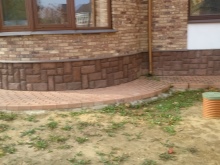
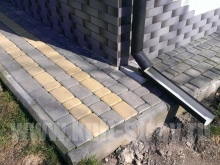

It is necessary to take care of the appearance of the coating. Structures framed along the edge with a decorative paving stone border look very impressive - this gives the entire structure an architectural completeness.
Depending on the wishes of the owner of the building, the blind area can be represented as a simple covering, almost not protruding above the ground, or it can rise by a couple of tens of centimeters.
The paving area creates order on the site, it looks harmoniously next to trees and flower beds, emphasizing the finishing of the building's facade favorably. At the same time, installing it with your own hands does not require large financial costs and special skills. The device of paving slabs near the house is within the power of any person.
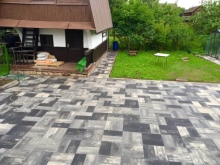
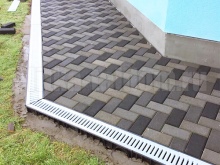
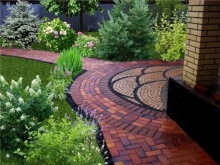
Watch a video on the installation of a blind area around the house from paving slabs.













The comment was sent successfully.